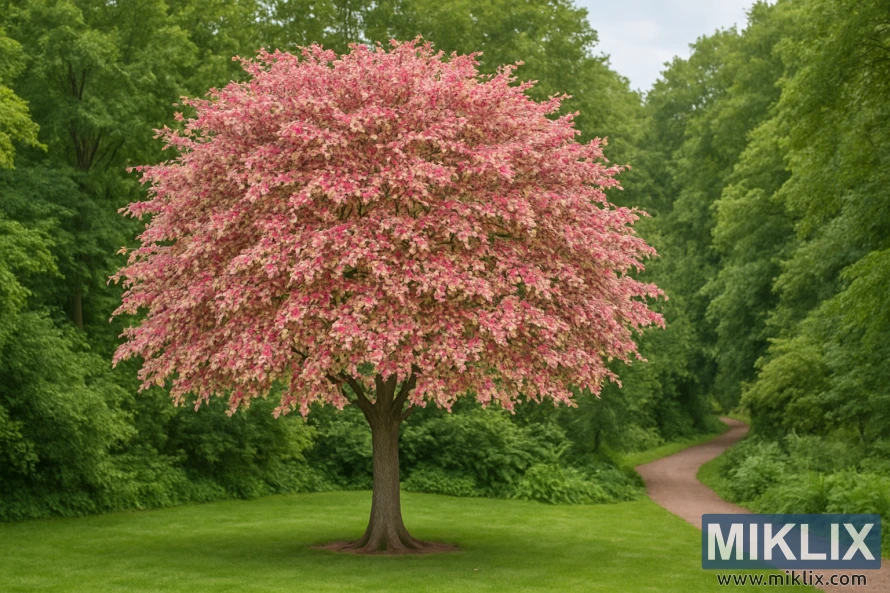Image: Tricolor Beech Tree
Published: August 28, 2025 at 10:13:39 AM UTC
Last updated: September 28, 2025 at 8:33:37 AM UTC
A mature Tricolor Beech with variegated purple, pink, and white foliage forms a striking canopy, serving as a colorful centerpiece in a garden.
In this idyllic garden scene, the Tricolor Beech (Fagus sylvatica ‘Purpurea Tricolor’) emerges as a living work of art, its canopy glowing with an extraordinary palette of colors rarely found in a single tree. The dense foliage shimmers with a painter’s precision, each leaf patterned in delicate variegation—soft washes of blush pink mingling with creamy white margins and a foundation of deep purplish-green. From a distance, the effect is that of a flowering tree in perpetual bloom, yet on closer inspection it is revealed to be foliage alone, a triumph of nature’s complexity that renders the tree a perennial spectacle. The entire crown forms a broad, rounded dome, balanced and symmetrical, giving the impression of a carefully sculpted canopy that nevertheless retains its natural grace.
At the base, the smooth, silvery-gray trunk rises with quiet strength, grounding the flamboyance above with understated dignity. Its bark, fine and unbroken, contrasts beautifully with the exuberance of the crown, emphasizing both the structural solidity and refined elegance for which beeches are renowned. Wide-reaching roots anchor it firmly into the lush, green lawn, their subtle flares at the base reinforcing the sense of permanence and stability that allows the dazzling canopy to take center stage without losing the harmony of form.
Surrounding the Tricolor Beech is a sea of verdant green, provided by the woodland edge that frames the scene. The dense backdrop of ordinary foliage only heightens the drama of the beech’s coloration, allowing the tree to stand forward like a jewel against velvet. This juxtaposition of rich greens with the variegated pinks and whites enhances the perception of depth and saturation, making the tree appear almost luminous. The winding garden path that curves softly into the distance adds both perspective and narrative, suggesting movement through the landscape, as if inviting a leisurely stroll beneath the canopy and beyond into the shaded recesses of the woodland.
The seasonal beauty of the Tricolor Beech further amplifies its ornamental value. In spring, the new leaves emerge in their brightest hues, a kaleidoscope of pink and cream that seems to glow in the fresh light of the season. Through summer, the colors mature but remain vivid, ensuring months of visual interest. In autumn, the foliage deepens into warmer tones, mingling bronzes and purples with lingering pinks, offering yet another transformation that extends its charm well beyond the flowering season of most ornamental plants. Even in winter, when the leaves have fallen, the smooth gray trunk and elegant branching structure retain their sculptural appeal, ensuring that the tree never loses its role as a focal point in the garden.
The Tricolor Beech’s enduring charm lies not only in its foliage but in the way it transforms a landscape. Whether placed as a solitary specimen on an open lawn, as in this image, or incorporated into a more complex planting scheme, it brings drama, sophistication, and a sense of artistry to its surroundings. It is a tree that captures attention at first glance, yet rewards closer inspection with endless detail, each leaf a unique brushstroke in a greater composition.
This image perfectly conveys why the Tricolor Beech is celebrated as one of the finest ornamental trees available to gardeners and landscape designers. Its canopy, bursting with vibrant variegation, stands like a beacon of elegance amid the more subdued tones of its environment. The combination of structure, color, and presence allows it to embody the union of beauty and permanence, making it not merely a tree, but a living sculpture that brings joy and sophistication to any garden in which it grows.
The image is related to: Best Beech Trees for Gardens: Finding Your Perfect Specimen

